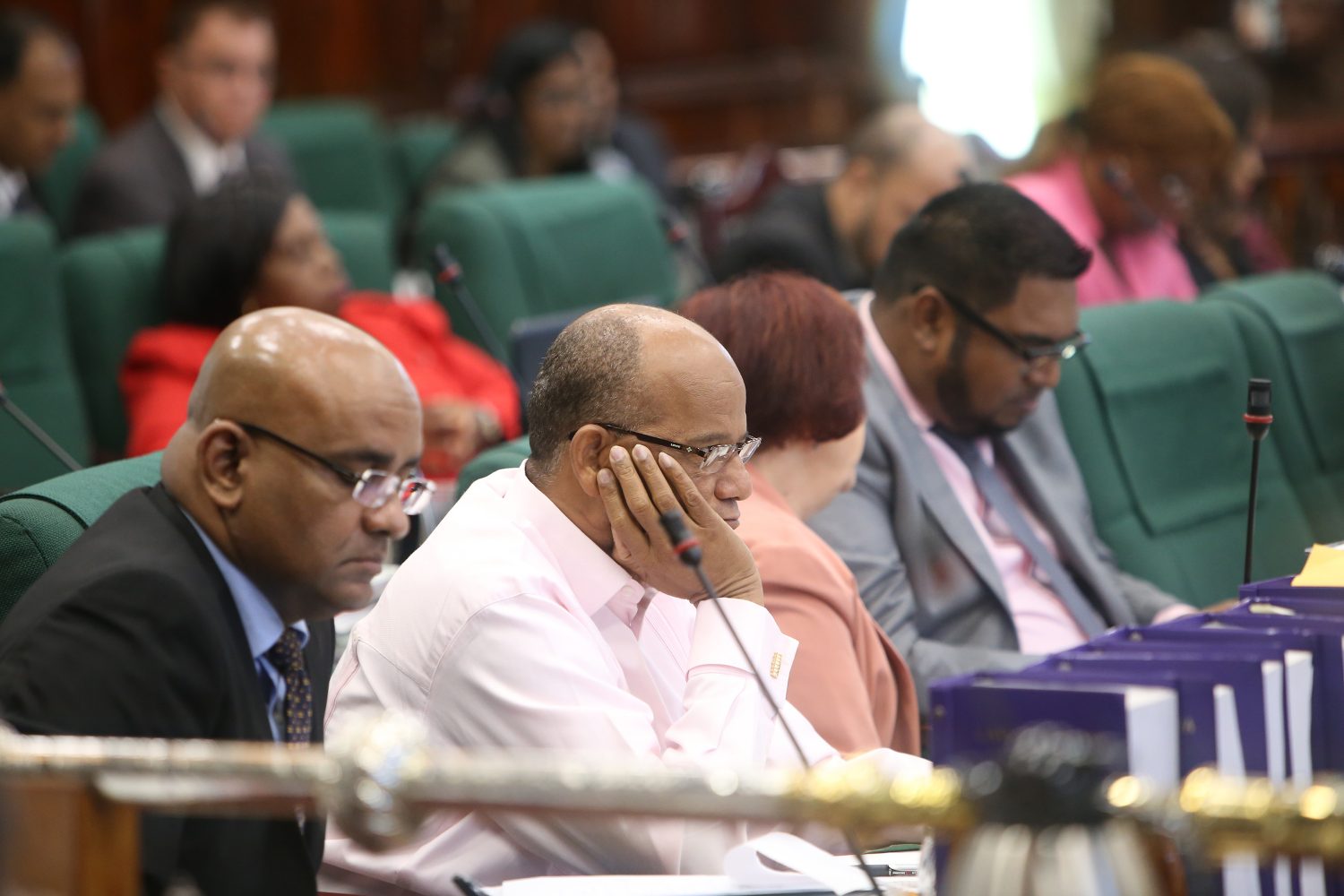Under the fourth APNU+AFC Budget styled `The Journey to the Good Life Continues’, real growth of the economy next year is targeted at 3.8%, with the non-sugar growth rate anticipated to be 4.6%. The budget itself is $267.1 billion, a 7.1 % increase over the revised Budget 2017.
The economic growth projection of 3.8% for 2017 was adjusted downward to 3.1% then 2.9%.
When he presented the 2017 budget last year, Minister of Finance Winston Jordan had projected a growth of 3.8% on the back of mining and quarrying and an expected recovery in other sectors however by mid-year, an economic growth rate of 2.2 % was achieved. Though this represented a 2% increase over the same period in 2016, the Mid-Year Report, revised downwards the overall growth to 3.1% on account of expected weak performance in the mining and quarrying sector, and the sugar and forestry industries. In presenting the 2018 budget yesterday afternoon, Jordan noted that the new projection for real growth of the economy, in 2017, is 2.9 %. Meanwhile for 2018 a 3.8% growth is once again projected.
“We anticipate that growth across all sectors, with the exception of sugar, will allow this target to be realized,” Jordan told the house.
He also noted that the overall balance of payments is expected to improve slightly to a deficit of US$53.1 million in 2017. This outcome, the minister explained, will be primarily driven by an improvement in the capital account, from a deficit of US$13.2 million, in 2016, to an anticipated surplus of US$181.8 million, in 2017, in spite of the deterioration of the current account from a surplus of US$13 million, in 2016, to a projected deficit of US$235 million, in 2017.
According to Jordan, the agriculture, fishing and forestry sectors are expected to recover this year, with an estimated growth of 0.2%, up from the 10.3% decline recorded for 2016.
The rice industry is expected to record an output of 602,087 tonnes for 2017, an increase of 12.7 % over 2016.
“This is due mainly to an additional 14,000 hectares planted for the 2017 spring crop and a further 4,481 hectares planted in the autumn crop [as well as] an improvement in the yield,” Jordan explained adding that these developments stem from farmers‘ renewed confidence in their ability to access new markets which has been helped by the recent attendance by the private sector at the Havana International Fair, in Cuba. This visit helped to stimulate further investment in the industry.
Sugar production, however, is projected to decline to 152,000 tonnes in 2017, a 17.2% reduction compared to 2016‘s output. The minister noted that opposition to the ongoing restructuring of the sugar industry led to the loss of almost 22,000 man days due to industrial action.
Jordan stressed that government’s intensified focus on diversification and value-added production in the non-sugar agriculture sector is absolutely critical while the sugar industry continues to undergo restructuring.
He explained this that is key to ensuring that the sector remains productive and growth-stimulating. Government has allocated $6.3 billion, in 2018, to support the reduced operations of GuySuCo.
“In 2018, the Special Purpose Unit (SPU) is tasked with examining and articulating the way forward with respect to the divestment of the Skeldon, Rose Hall, and East Demerara estates. With respect to the remaining estates, the SPU will also work to reconfigure operations to guarantee economic viability. Our taxpayers must no longer be burdened to carry the weight of an un-profitable, inefficient, and antiquated public corporation,” Jordan declared.
He further clarified that Government intends to uphold its duty to the communities and families in the areas affected by divestment, as part of the GuySuCo restructuring. Measures to assist these communities include a skills re-training programme for those who choose to pursue new opportunities while those who wish to continue with a livelihood in agriculture may see an opportunity to own their own farmland. Further Government has committed to assuming responsibility for social services, including health centres and community centre grounds as well as critical drainage and irrigation services for the areas affected by divestment.
Meanwhile, the mining and quarrying sector is anticipated to contract by 1.9%, compared to the 46.1% expansion in 2016. While gold declarations are expected to remain stable, bauxite production and other mining will decline by 2.3% and 12.6%, respectively. Gold declaration is expected to amount to approximately 712,706 ounces while bauxite production is projected to decline to 1,417,557 tonnes for 2017 as a result of inclement weather and mechanical problems that resulted in significant down time.
In the financial sector inflation is projected at a moderate 2%. The average price level across the economy as measured by the consumer price index (CPI), was projected at 2.5% in Budget 2017 however according to Jordan with a slower growth in demand and consumer spending, the inflation rate was moderate at the half year and continued through to the end of the third quarter with inflation recorded at 1.5%.
The Minister argued that even allowing for the seasonal increase in spending in the fourth quarter, the end-of-year projection has been revised to a moderate 2%.
Also expected to remain stable is the Bank of Guyana exchange rate of the Guyana Dollar to the US Dollar. It is expected to remain stable at $206.5.
“Earlier in the year, the Bank of Guyana moved to implement countervailing measures to prevent manipulation of the foreign exchange rate and to ensure a greater and smoother flow of receipts to the foreign currency market,’ he said adding that the exchange rate for the Euro at the commercial banks appreciated against the Guyana Dollar by 7.7%, between January and September of 2017, the Pound Sterling by 6.6% and the US Dollar by 1.6 % against the Guyana Dollar.
Additionally, the total stock of public debt is projected to increase from US$1.60 billion, in 2016, to US$1.66 billion in 2017 corresponding with a further declining total public debt-to-GDP ratio of 45.2%, in 2017, relative to 45.7 %, at the end of 2016.
Specifically the external debt-to-GDP ratio is expected to increase from 33.2 %, in 2016, to 33.6 % in 2017, as a result of faster growth in the external debt stock, from US$1.16 billion, in 2016, to US$1.23 billion in 2017, when compared with growth in the GDP. Meanwhile the stock of domestic debt is projected to decline from US$438.6 million, in 2016, to US$427.8 million, in 2017, representing a decrease of 2.5%.
Total external debt servicing will however increase by 16.6 %, from US$53.7 million, in 2016, to US$62.7 million, in 2017 due to higher principal and interest payments to several multilateral creditors, one bilateral creditor and one private creditor.
“In spite of this, the cost of servicing our external debt obligations remains manageable, consuming a mere 5.7% of the projected central government revenue for 2017. This represents a significant reduction from the 23.7 % and 12.6 % recorded for 2014 and 2015, respectively,” Jordan explained.
Also increasing is the domestic debt servicing. This is expected to increase by 16.8%, from US$9.3 million, in 2016, to US$10.9 million, in 2017, primarily due to the payment of the National Insurance Scheme (NIS) debentures issued in 2016 to assist in recovering the impaired investment in the Colonial Life Insurance Company (Guyana) Limited (CLICO).
2018
For 2018 growth in the agriculture, fishing, and forestry sector will, according to Minister Jordan be driven by the expected expansion in the various subsectors, except sugar. Overall, the agriculture, fishing, and forestry sector is anticipated to contract in 2018 by 0.7 %, largely due to the challenges facing the sugar industry.
He explained that building on the solid performance in 2017, the rice industry is expected to expand to 617,353 tonnes, an increase of 2.5 %. The other-crops subsector is anticipated to grow by 2.3 %, as diversification efforts continue and productivity gains are made. The forestry subsector is expected to grow by 8 % to 320,760 cubic metres, as the reallocation of concessions continue, new concessionaires establish operations, and stimulus measures are put in place in 2018. The livestock and fishing subsectors are projected to grow by 2% and 2.3%, respectively, driven by consumer demand.
On the other hand, sugar production is expected to contract by 24% to 115,447 tonnes.
The mining and quarrying sector is projected to rebound in 2018, expanding by 5%. This growth will be driven by the bauxite, gold, and quarrying industries. The bauxite industry is projected to produce 1,897,205 tonnes, resulting in an increase of 23.3%. Gold declaration is budgeted at 736,000 ounces, an improvement of 3.3%, as a result of favourable prices, as well as measures by regulatory bodies to improve recovery rates and ensure compliance. Other mining is anticipated to grow by 3.8%, premised on increased activity in the construction sector.
During that same period inflation is expected to be 2.4% while the balance of payments deficit in 2018, is expected to widen to US$79.7 million from US$53.1 million in 2017. Central Government overall deficit is projected to be 5.4% of GDP in 2018, below the budgeted 5.6% of GDP for 2017.
“This increase is driven by an expansion of the current account deficit to US$292.6 million, from US$235 million in 2017, due to a widening of the merchandise trade deficit. Imports are projected to increase at a higher rate than exports, with growth in each projected to be 5.7% and 0.8%, respectively,” Jordan said.
Exports are also projected to rise in 2018, as both production and commodity prices are expected to rise, with gold receipts projected to continue to strengthen. Gold, timber, and other exports, which account for nearly 78% of all exports, will see an increase in export earnings. Growth in merchandise imports is forecasted at 5.7% driven primarily by non-petroleum imports. The capital account surplus will increase marginally to US$212.9 million, on account of higher net inflows to the private sector in the form of foreign direct investment which will be driven by expansion of activities in the petroleum industry.
Also anticipated to rise is total revenue which is expected to reach $201.9 billion in 2018. This is driven by a projected rise in tax revenue by 7.3%. Non-tax revenue however is expected to decline by 13.1% to $20.5 billion, as a result of a decline in transfers from statutory bodies by $3.8 billion.
Central Government expenditure is expected to increase by 6% to $256.8 billion. Recurrent expenditure is anticipated to grow to $197.1 billion in the coming year, an increase of 7.1%. This will be driven by an 8.6% increase in personal emoluments, to $59 billion; a 6.5% increase in transfer payments, to $76.7 billion; and an 8.3 % increase in interest payments, to $8.7 billion. Capital expenditures are budgeted to rise by 2.7%, to $59.7 billion.










